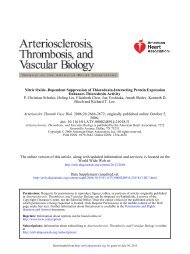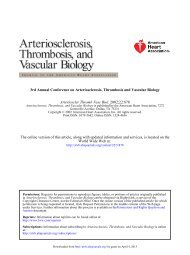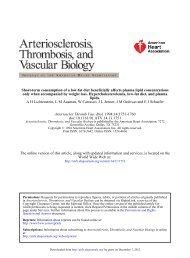CX3CR1 Deficiency Confers Protection From Intimal Hyperplasia ...
CX3CR1 Deficiency Confers Protection From Intimal Hyperplasia ...
CX3CR1 Deficiency Confers Protection From Intimal Hyperplasia ...
Create successful ePaper yourself
Turn your PDF publications into a flip-book with our unique Google optimized e-Paper software.
2058 Arterioscler Thromb Vasc Biol. September 2006<br />
Statistical Analysis<br />
Numerical data presented in text and figure are expressed as<br />
meanSEM. All sections were analyzed by 2 investigators, 1<br />
blinded and 1 unblinded, with an inter-rater reliability of 0.95 to<br />
0.99. Fisher’s exact test was utilized to determine incidence. Student<br />
unpaired t test was used to compare average numbers of cells or<br />
percentages between experimental groups. In all cases, P0.05 was<br />
considered significant.<br />
Results<br />
Characterization of <strong>Intimal</strong> <strong>Hyperplasia</strong><br />
After Injury<br />
Wire injury resulted in endothelial denudation as evidenced<br />
by an absence of endothelial cells in femoral arteries from<br />
WT mice 24 hours after injury. The contralateral, uninjured<br />
control vessels retained their normal histology. Platelet adhesion<br />
to the injured vessel wall at day 1 was followed by<br />
monocyte recruitment to the intima by 5 days after injury<br />
(Figure 1). At 14 days, the neointima was a mixture of<br />
monocytes and VSMCs, and by 28 days, the neointima was<br />
primarily composed of VSMC (Figure 1). Taken together,<br />
intimal hyperplasia was readily apparent by 5 days and it was<br />
continuously detected between 5 and 28 days after injury.<br />
Monocyte recruitment to the intima occurred earlier than<br />
VSMC accumulation, which was the primary cellular component<br />
of neointima in the late stage (day 28). Eighty-six<br />
percent of WT mice developed intimal hyperplasia with an<br />
average Intima/Media (I/M) ratio of 0.8.<br />
CX 3CL1 Expression Is Induced in Injured Arteries<br />
To define the role of CX 3CR1 in the response to arterial<br />
injury, we first examined the expression pattern of its ligand,<br />
CX 3CL1, by immunohistochemistry. CX 3CL1 expression was<br />
undetectable in non-injured, control arteries at any stage of<br />
the injury response. In injured arteries, CX 3CL1 was not<br />
detected at day 1. At day 5, CX 3CL1 was expressed in<br />
endothelial cells and in a subset of the intimal SMC in WT<br />
and CX 3CR1 / arteries (Figure 2). This pattern of expression<br />
continued through the injury response. These data provide the<br />
evidence that CX 3CL1 may be involved in the pathogenesis<br />
of guide wire induced vascular injury.<br />
CX 3CR1-Deficient Mice Are Protected <strong>From</strong><br />
<strong>Intimal</strong> <strong>Hyperplasia</strong><br />
To assess whether CX 3CR1 plays a role in mediating intimal<br />
hyperplasia after arterial injury, we measured the incidence<br />
and extent of neointima formation in CX 3CR1 / and WT<br />
mice. The overall incidence of intimal hyperplasia at 5, 14,<br />
and 28 days was decreased in CX 3CR1 / mice by 58% (8/21<br />
Figure 1. Cellular composition of injured<br />
arteries. Shown are immunohistochemical<br />
analyses of WT arteries at 0, 1, 5, 14,<br />
and 28 days after arterial injury. Platelets<br />
(brown), monocytes (brown), and VSMCs<br />
(red) were identified by anti-thrombocyte,<br />
anti-F4/80, and anti--actin antibodies,<br />
respectively.<br />
KO versus 26/29 WT, P0.0017). Compared with the<br />
average intimal area in WT mice, the average intimal area in<br />
CX 3CR1 / mice was reduced by 84%, 56%, and 74% at 5,<br />
14, and 28 days, respectively (Figure 3). In contrast, no<br />
significant differences in luminal and medial areas were<br />
detected between WT and CX 3CR1 / arteries (data not<br />
shown). These data indicate that CX 3CR1 deficient mice are<br />
protected from intimal hyperplasia after acute arterial injury,<br />
and that the arterial injury model is appropriate to study the<br />
functional roles of CX 3CR1.<br />
Normal Platelet Function in CX 3CR1 / Mice<br />
To define whether platelet CX 3CR1 is functionally relevant in<br />
guide wire induced injury, we examined platelet accumulation<br />
on the injured luminal surface by immunostaining. By<br />
morphometric analysis, there was no difference in the area of<br />
the platelet thrombus that accumulated along injured<br />
CX 3CR1 / and WT arteries (Figure 4A and 4B). We also<br />
examined platelet function under near-physiological conditions<br />
in vitro using blood collected from CX 3CR1 / and WT<br />
mice. As shown in Figure 4C and 4D, the absence of CX 3CR1<br />
did not affect shear-induced platelet thrombus formation.<br />
These data suggest that platelet CX 3CR1 may be not an<br />
essential mediator of platelet adhesion or aggregation in<br />
response to arterial injury or high shear.<br />
Defective Monocyte Recruitment in<br />
CX 3CR1 / Mice<br />
CX 3CR1 is believed to be critically important for monocyte<br />
recruitment to the inflamed or injured vessel. We tested this<br />
hypothesis by examining monocyte infiltration into the vascular<br />
wall by F4/80 antigen staining (Figure 5A). There was<br />
a 100% and an 87% decrease in monocyte accumulation in<br />
CX 3CR1 / mice at 5 and 14 days, respectively, compared<br />
with WT mice (Figure 5B). Monocyte adhesion to CX3CL1<br />
Figure 2. CX 3CL1 staining in injured vessels. Immunostaining of<br />
CX 3CL1 and endothelial cells (vWF) in WT mice is shown in control<br />
and injured arteries at 5 days after injury. Control arteries<br />
have no CX3CL1 expression and injured arteries show expression<br />
of CX3CL1 by vWF endothelial cells.<br />
Downloaded from<br />
http://atvb.ahajournals.org/ by guest on March 25, 2013














